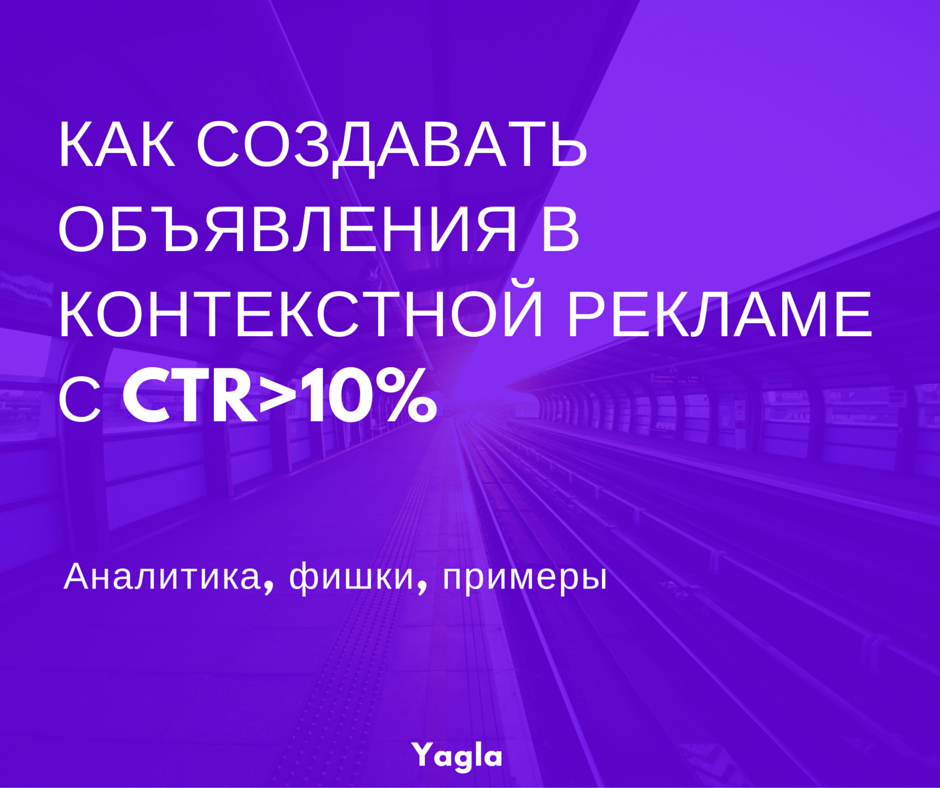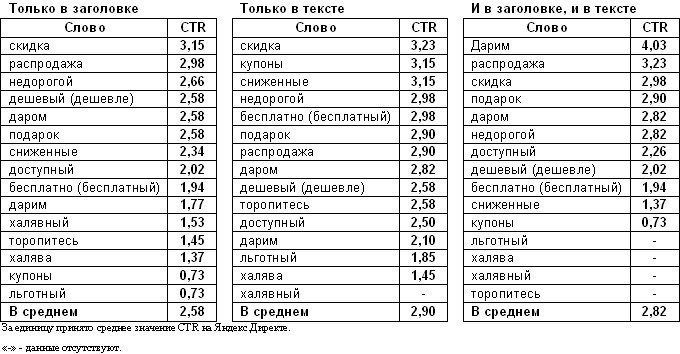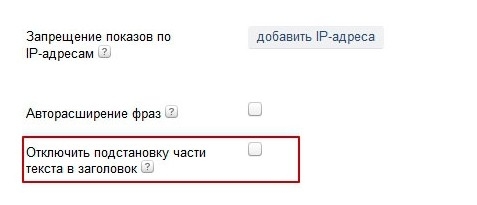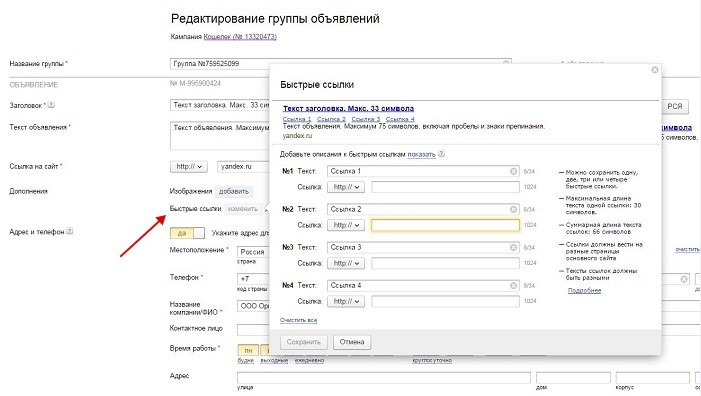How to create contextual ads with a clickthrough rate greater than 10%

In this article, you will learn the secret magic of CTR in the context of how to make a competitive analysis of a ready-made template and what conclusions to draw from it; 10 chips when creating ads; You’ll see the process of creating an attractive ad + features of ads in the Yandex Advertising Network and Google Adwords. On specific examples, with screenshots.
Secret magic of CTR
Surely you met materials in the spirit of “How to create a killer headline in 5 minutes”, “100 words that will even sell snow to the Eskimos”, etc. Here’s a list of “word magnets” with statistics that walks in RuNet (there are stimulant words even in the official Yandex.Direct help):

Allegedly, they are guaranteed to increase the CTR of ads. There is some truth here, while it is worth considering three important points:
1) Lovers of freebies, or users with a weak interest in the product, flock to the "words-magnets". Get a ton of dirty traffic - do you need it? An exception is a campaign with a stock where a cheap price is the main condition of the offer.
2) The lure for discounts and gifts does not work in all niches. It would be foolish to advertise, for example, "Equipment for the oil industry is inexpensive." There are other patterns of consumption. Or a unique product, when consumers have nothing to compare and the price is considered secondarily. Basically, such things work in B2C, excellent - with premium goods. A lot of people would probably peck on the iPhone 6 at a 50% discount, CTR took off, but what is the return?
3) High CTR is not equal to high sales. It depends on the following stages of the funnel - the offer on the landing page and the work of managers (or the conditions for placing an order and delivery in an online store). Consider the return on the ROI level of the entire advertising campaign - whether discounts and gifts pay off. First of all - the cost of one lead (CPL indicator) - how much money you spent on getting one call, visit or application from advertising.
To increase the click-through rate, some advertisers put “discounts, gifts, hurry” in almost every ad, even if there really are no bonuses. The problem is that going through an ad is just the first step, and a high CTR alone doesn’t mean anything. At the same time, a decrease in the cost of a click (the higher the CTR, the lower the cost of a click) should not be misleading.
Look at the relationship with CPL (circulation cost). This is a key indicator of the advertising campaign (more precisely, the basic KPI before calculating the ROI). “Dirty” technicians inflate him greatly due to inappropriate traffic. Ultimately, you need customers, not clicks, right?
Competitive analysis
See competitors' offers, how they write ads, how these ads differ. Particular attention is paid to leaders in special accommodation: as a rule, there are the most powerful offers. For convenience, use the competitive analysis table (you can take our template as a basis ). It will help you understand who has pros and cons and what to focus on in your ads.
We analyze the competitive analysis using a specific example, on the basis of which the template was created (copy the template and paste your data; you can hide unnecessary parameters). So, a typical commercial request “Buy an iPhone”:

What conclusions do we make?
No. 1 - stands here for branding, we do not pay special attention to it. Apple is Apple)
What's good: an expanded title, a quick Buy link. At the same time, the extended title is the slogan of the iPhone 6S release (“The only news is everything is new”). He talks about image, not about benefits.
No. 2 - The usual heading with a key phrase where the site address is "pulled". What's good: a high rating on Yandex Market (twice as much as Apple), and this is a very powerful social proof. All other things being equal - a strong argument in favor of the seller.
No. 3 - A short title with a key. What's good: the headline is formulated in an imperative mood, as a call to action - “Buy an iPhone” + extension with a phone number.
And in fact, and in another case, there is essentially no offer. The standard set of idle talk is “Quality, an excellent choice, fast delivery”, which is typical for “market monsters”.
All parameters are in the comparison table .
In fairness, the request is too blurry - it is not clear by what criteria the user chooses and which model. Therefore, we will try to “hook” with the help of several triggers, only more specific.
Create an attractive ad.
We take the same request - “Buy iPhone”. Judging by the fact that a specific model and parameters of the offer (guarantee, new or used and so on) are not indicated, the user selects “from and to”.
We build a value proposition (offer) on fast delivery and price. We repeat the exact request and get the title: “Buy iPhone. Delivery today! iPhone from 12 990 rubles. " Extended view header. Recall that from this year Direct allows you to increase 33 characters to 56. The first phrase from the text of the announcement is "pulled" to the main part. Otherwise, Direct displays the URL of the site. Therefore, expect that the headline gets some kind of benefit that attracts the attention of the audience.
If you do not want to use this feature, you can disable it in the "Advanced Settings" section in the campaign parameters:

In the text, we indicate 2 more criteria - “Rostest” (reliability, authentication) and “Warranty 12 months” + motivator “Choose a cover as a gift”.
The ability to enter quick links opens in the corresponding tab of the ad editor:

We have links to different models. Finally, in the extensions we enter the phone and the operating mode on weekdays and weekends. As a result, we get this ad:

3 key points that affect CTR.
From our practice, we have identified only 3 points that affect the clickability of the ad. Of course, we will not discover America, but as a generalization it is useful.
1) Exact access to the target audience. This is about the issue of minus in particular and cleaning the advertising campaign from inappropriate “slag” in general. There are, of course, cases where giants stand on inappropriate requests for branding. But this is another story)
2) The exact occurrence of the request in the header. This is the first thing that users pay attention to. Moreover, Direct highlights keywords in the headline, text, and quick links.
3) Benefits or triggers. We analyze what is important for the audience specifically for this request (again, an argument in favor of writing ads for every need). Price, the ability to buy on credit or a specific product in stock. We make a clear, concrete proposal without abstractions (high-quality, best, low price).
For example, in a campaign for a rebar, the semantics were expanded for exact queries from the assortment. If a person enters "15ls22nzh", he is 100% in the subject and knows what he is looking for. We show that we have this item in stock, see the prices on the website:

CTR of this announcement is 15.74%.
Another example is a car buying and sharing center. The request is not quite specific - "Auto exchange." We hypothesize that speed is important for such a consumer: quickly evaluate a car, quickly get money.
Ad:

CTR - 22.36%.
As you can see, everything is quite simple: we give specific users what they want. This is the benefit of analytics and segmentation of the target audience. And to highlight an ad visually, to help - the following list of working methods.
10 chips when creating ads
These are the highlights that make the ad stand out from the competition.
1) Advanced heading with benefits;
2) Exclamation and question marks in the headline and ad text. In this case, do not put them after each phrase, as in the example below. Everything is good in moderation)

3) Advanced mode of operation. A little trick for offline companies that we found in the example of Pavel Nekrasov:

4) The catchy favicon. In Yandex.Direct it is shown by default, if it is on the site. Someone specifically “zapilivaet” such a favicon for highlighting:

5) Quick trigger links. We design in the form of advantages, based on the needs of the audience. Therefore, instead of the "About Us", "Contacts" links and other garbage, we collect clicks on what really excites potential consumers.
For instance:

Compare with second and third places.
Another option:

Important: each link leads to a separate page.
6) Geolocation (city, metro station);

7) Phone in extension under quick links;

8) Cost of goods and delivery times. This is attractive when the price is the main selection criterion and you have a better offer than your competitors. By the way, many advertisers intentionally indicate the price in all cases. On the one hand, this reduces the CTR, on the other hand, the effectiveness of the campaign as a whole increases, since you immediately cut off those who are "expensive".

9) Call in the form of target action. What should the user do on the landing page - call, leave a request, receive a gift? Therefore, the emotional call "Push!" it’s better to leave it for YAN (Yandex Advertising Network), which has a different user behavior model.
A good example:

10) Rating on Yandex Market. We show when the rating is 4-5. Otherwise, the opposite effect of mistrust may work.

Ads in YAN (Yandex Advertising Network)
In YAN, we are calculating a completely different model of user behavior. Here people are not looking for your product purposefully, especially on partner sites.
Important points:
1) Attractive images. In YAN, the visual, perhaps, catches stronger than the text. Therefore, on teasers, special attention.

Yandex Help for adding images: yandex.ru/support/direct/features/images.xml
2) Emotional texts of ads. Up to the headlines a la "yellow press". At a minimum, the headline should catch the audience “for the living”:

3) An emotional, imperative call to action. Necessarily with an exclamation mark. What is not always appropriate in search ads is a must have in YAN. These are calls “Press!”, “Come in!”, “Look!” as in the example above.
What about google?
Yandex.Direct technology has almost reached out to Edwards, and of Google’s unique features, we’ll mention refinements. This is an additional line in the extensions, under quick links, where you can note important things that are not included in the ad text:

PS In the next article, we’ll look at conversion optimization in the next step — how to create 4U headings on landing pages.
Share your opinions and experiences in the comments + can ask questions about your campaigns.
